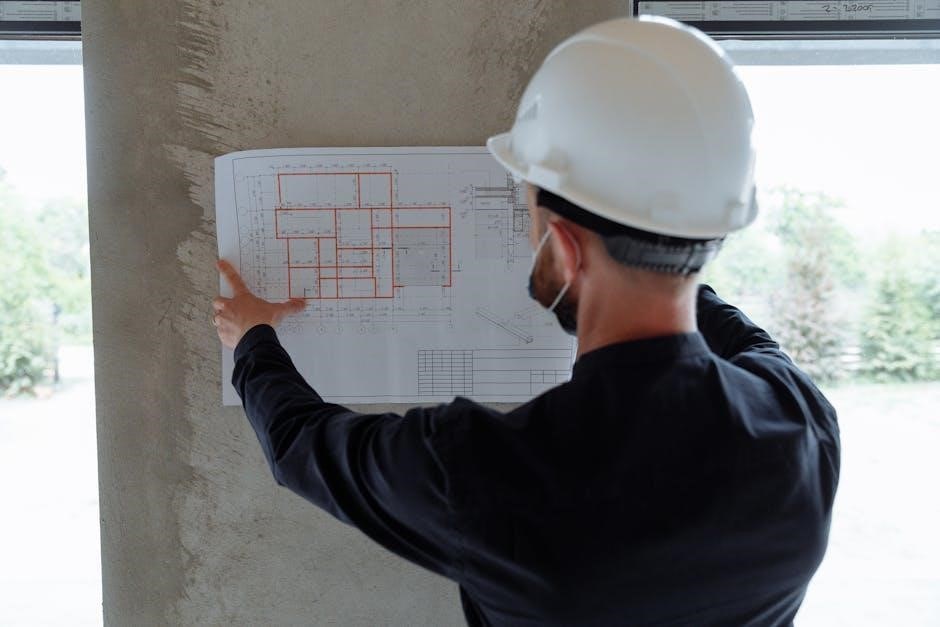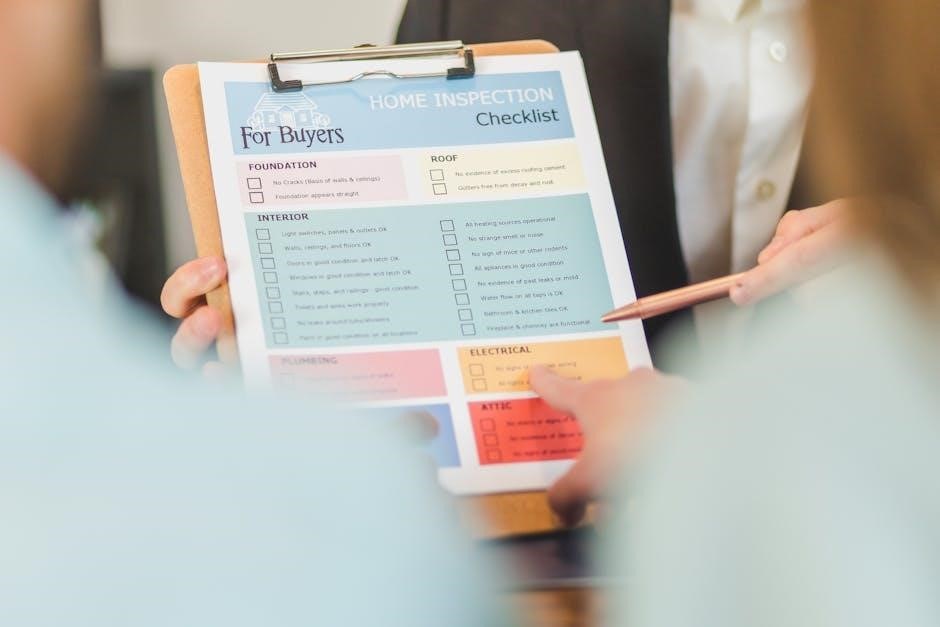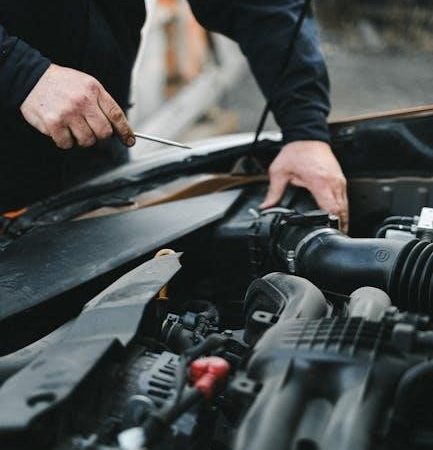The NSPIRE Inspection Checklist is HUD’s new standardized protocol for ensuring rental properties meet safety and quality requirements. It replaces older inspection standards and provides a comprehensive guide for landlords and inspectors, promoting compliance and streamlined inspection processes.
1.1 What is NSPIRE?
NSPIRE (National Standards for Physical Inspection of Real Estate) is HUD’s new protocol for evaluating rental properties under the Housing Choice Voucher (HCV) and Project-Based Voucher (PBV) programs. It replaces outdated inspection standards, focusing on standardized, objective criteria to ensure safe, decent, and sanitary housing conditions. NSPIRE emphasizes habitability requirements, simplifying the inspection process while maintaining compliance with federal regulations. This system aims to improve consistency, reduce delays, and enhance overall quality of housing inspections nationwide.
1.2 Purpose of the NSPIRE Inspection Checklist
The NSPIRE Inspection Checklist is designed to ensure compliance with HUD’s housing standards, promoting safe, decent, and sanitary living conditions for tenants. Its purpose is to streamline the inspection process, improve consistency, and reduce subjectivity in evaluating rental properties under the HCV and PBV programs. The checklist provides a clear, standardized framework for inspectors and landlords to identify and address deficiencies, ensuring properties meet federal requirements while protecting tenant health and safety. It also aims to reduce administrative burdens and enhance overall program efficiency.
1.3 Key Features of the NSPIRE Checklist
The NSPIRE Checklist includes standardized inspection protocols, affirmative habitability requirements, and specific pass/fail criteria for rental properties. It focuses on critical health, safety, and functional items, ensuring consistency across inspections. The checklist simplifies the evaluation process by categorizing deficiencies and providing clear guidelines for inspectors. Key features also include detailed documentation requirements and a structured format that reduces subjectivity. This ensures properties meet HUD’s standards effectively while maintaining clarity and transparency for both landlords and tenants;

NSPIRE HCV/PBV Inspection Checklist Overview
The NSPIRE HCV/PBV Inspection Checklist provides a comprehensive guide for Housing Choice Voucher and Project-Based Voucher programs, outlining HUD’s inspection standards to ensure safe and quality housing.
2.1 Structure of the Checklist
The NSPIRE HCV/PBV Inspection Checklist is organized into clear sections, starting with property details like Family Identifier and Owner information. It then proceeds to major inspection areas, including exterior, interior, kitchen, bathroom, and safety systems. Each section contains specific items to evaluate, such as dryer vents, fire extinguishers, and carbon monoxide detectors. The checklist uses a straightforward format with checkboxes and notes, ensuring inspectors systematically assess all critical aspects of a property to determine compliance with HUD standards.
2.2 Major Sections of the Checklist
The NSPIRE HCV/PBV Inspection Checklist is divided into key sections, including exterior conditions, interior unit conditions, and safety requirements. It covers essential areas like functionality of plumbing, electrical systems, and appliances. Additional sections focus on fire safety, carbon monoxide detectors, and proper ventilation. Each category is designed to ensure compliance with HUD standards, providing a thorough assessment of habitability and safety. The checklist also includes a section for documentation and notes, allowing inspectors to record observations and deficiencies effectively. This structured approach ensures all critical aspects of a property are evaluated systematically.

2.3 How to Use the Checklist Effectively
To use the NSPIRE Inspection Checklist effectively, start by thoroughly reviewing each section to understand the requirements. Prioritize critical items, such as safety hazards, and address them first. Document findings meticulously, including notes and photos, to track necessary repairs. Consider using digital tools for efficiency and maintain regular maintenance schedules to prevent issues. Involve tenants in identifying problems early and understand inspector priorities, especially regarding fire safety. Stay updated with HUD resources and updates to ensure compliance and adapt to evolving standards. This systematic approach ensures a safe and habitable environment while avoiding potential penalties.

Affirmative Habitability Requirements
Affirmative Habitability Requirements ensure rental units meet HUD’s safety and quality standards. Compliance with 24 CFR 5.703(d) is mandatory, focusing on critical aspects like smoke detectors, window functionality, and secure doors.
3.1 Key Requirements per 24 CFR 5.703(d)
24 CFR 5.703(d) outlines affirmative habitability requirements for rental units. Key requirements include operational smoke and carbon monoxide detectors, functional windows and doors, proper ventilation, and safe electrical systems. Units must also have secure locks, adequate lighting, and no evidence of pest or rodent infestation. Additionally, all plumbing fixtures must function correctly, and there should be no leaks or water damage. These standards ensure a safe and healthy living environment for tenants, aligning with HUD’s guidelines for habitability under the NSPIRE inspection protocol.
3.2 Role of NSPIRE in Ensuring Habitability
NSPIRE plays a critical role in ensuring habitability by standardizing inspection processes and identifying potential safety hazards. It streamlines compliance checks, ensuring rental units meet HUD’s minimum standards. NSPIRE focuses on essential systems like electrical, plumbing, and HVAC, as well as structural integrity and environmental hazards. By emphasizing proactive inspections, NSPIRE helps maintain safe and healthy living conditions for tenants. Its structured approach aligns with HUD’s goal of promoting affordable, decent, and secure housing, making it a vital tool for enforcing habitability requirements nationwide.
3.3 Common Deficiencies Identified
NSPIRE inspections frequently uncover issues such as damaged dryer vents, blocked egress points, and missing or expired fire extinguishers. Flammable materials near heating sources and improperly installed carbon monoxide detectors are also common findings. Additionally, handrails often fail to meet grippable requirements, and water heater temperature-pressure relief lines may be incorrect. These deficiencies highlight critical safety and habitability concerns that must be addressed to ensure compliance with HUD standards and maintain safe living environments for tenants.

Preparing for an NSPIRE Inspection
Preparing for an NSPIRE inspection involves reviewing the checklist, ensuring all units meet habitability standards, and gathering required documentation to streamline the inspection process effectively.
4.1 Steps to Prepare for the Inspection
To prepare for an NSPIRE inspection, landlords should review the checklist, ensure all units meet habitability standards, and address any potential deficiencies. Start by confirming the inspection date and ensuring the property is accessible. Next, verify that all required documentation, such as rental agreements and maintenance records, is organized. Conduct a self-inspection to identify and fix issues like blocked egress, expired fire extinguishers, or damaged dryer vents. Address any known deficiencies beforehand to avoid non-compliance. Finally, gather a list of repairs or updates needed and have a plan in place for addressing inspection findings.

4.2 Importance of Reviewing the Checklist
Reviewing the NSPIRE Inspection Checklist is crucial for ensuring compliance with HUD’s standards. It helps landlords and inspectors understand the requirements for habitability, safety, and quality. By familiarizing yourself with the checklist, you can identify potential deficiencies and address them before the inspection. This proactive approach streamlines the inspection process, reduces the risk of non-compliance, and ensures that all units meet the necessary standards. Regular review also helps in staying updated with any changes or updates to the inspection criteria.
4.3 Gathering Necessary Documentation
Gathering necessary documentation is essential for a smooth NSPIRE inspection. This includes lease agreements, maintenance records, and proof of safety equipment installation. Organizing these documents helps ensure compliance with HUD standards and streamlines the inspection process. Proper documentation demonstrates adherence to habitability and safety requirements, reducing the risk of deficiencies. It also provides clear evidence of completed repairs and updates, making it easier for inspectors to verify compliance. Staying organized saves time and helps avoid potential issues during the inspection.

Unit-Specific Inspection Items
Unit inspections focus on safety, functionality, and habitability. Key items include dryer vent condition, egress clearance, fire extinguisher presence, and proper water heater installation. These checks ensure compliance with NSPIRE standards and maintain tenant safety. Regular reviews help prevent common deficiencies like blocked exits or expired fire safety equipment. Proper documentation of these items is crucial for passing inspections and maintaining housing quality.
5.1 Exterior and Interior Unit Conditions
Exterior and interior inspections assess the overall condition of rental units. Inspectors check for damaged dryer vents, proper egress clearance, and absence of flammable materials. Interior checks focus on functional requirements, such as working smoke detectors, secure handrails, and proper water heater installation. These evaluations ensure units meet safety and habitability standards, addressing potential hazards like blocked exits or expired fire safety equipment. Regular inspections help maintain compliance with NSPIRE guidelines and promote a safe living environment for tenants. Proper documentation of these conditions is essential for inspection success.
5.2 Safety and Functional Requirements
Safety and functional requirements are critical in NSPIRE inspections. Inspectors verify fire extinguishers, smoke detectors, and carbon monoxide detectors to ensure they are present, functional, and meet regulations. Proper installation of water heaters and secure handrails are also checked. These requirements aim to prevent hazards, ensuring a safe living environment. Compliance with these standards is essential for passing inspections and maintaining habitable conditions. Landlords must address any deficiencies promptly to avoid failed inspections and potential penalties. Regular maintenance and inspections help uphold these critical safety measures.
5.3 Common Fail Items in Unit Inspections
Common fail items in unit inspections often include damaged dryer vents, blocked egress in bedrooms or entry doors, and missing or expired fire extinguishers. Flammable materials near heat sources and improperly installed water heaters are also frequent issues. Inspectors closely examine these areas to ensure compliance with safety standards. Addressing these deficiencies is crucial for passing inspections and maintaining habitable living conditions. Regular maintenance and proactive repairs can help prevent these common failures, ensuring units meet NSPIRE requirements and avoid potential penalties.

NSPIRE Inspection Checklist for Landlords
The NSPIRE Inspection Checklist helps landlords ensure rental units meet HUD’s safety and habitability standards. It outlines key responsibilities and requirements for maintaining compliant properties, avoiding deficiencies.
6.1 Landlord Responsibilities
Landlords are required to ensure their rental properties meet NSPIRE standards, maintaining safety, habitability, and compliance with HUD regulations. They must address deficiencies promptly, ensure proper documentation, and provide access during inspections. Key areas of responsibility include functioning electrical systems, proper smoke and carbon monoxide detectors, secure locks, and safe exterior conditions. Landlords must also ensure compliance with affirmative habitability requirements, such as proper water heater installation and unobstructed egress. Regular maintenance and inspections are essential to pass NSPIRE checks and avoid penalties.
6.2 Tips for Passing the Inspection
To pass an NSPIRE inspection, landlords should conduct pre-inspections to identify and address potential issues. Ensure all smoke and carbon monoxide detectors are functional, and fire extinguishers are up-to-date. Verify that egress paths are unobstructed, handrails are secure, and water heaters have proper TPR discharge lines. Regularly inspect and maintain electrical systems, plumbing, and appliances. Address dryer vent damage and ensure flammable materials are stored safely. Organize documentation, such as maintenance records, to demonstrate compliance. Promptly resolve any deficiencies to avoid inspection failures.

6.3 Consequences of Non-Compliance
Failure to meet NSPIRE inspection standards can result in penalties, including financial sanctions or legal action. Repeat non-compliance may lead to contract termination or loss of HUD funding. Landlords who fail inspections risk reputational damage and potential exclusion from future HUD programs. Tenants may also pursue legal remedies if habitability standards are not maintained. Understanding and addressing deficiencies promptly is critical to avoiding these consequences and ensuring continued participation in housing programs.

Downloading and Accessing the NSPIRE Checklist
The NSPIRE Inspection Checklist is available for download on HUD’s official website. Landlords and inspectors can access the PDF version directly from the HUD portal.
7.1 Where to Find the NSPIRE Checklist
The NSPIRE Inspection Checklist can be found on HUD’s official website. Visit the HUD portal and navigate to the “NSPIRE Resources” section. Look for the “Forms and Documents” tab, where the checklist is available for download. Ensure you access it from HUD’s official sources to guarantee accuracy and compliance. Additionally, the checklist can be located by searching for “NSPIRE HCV/PBV Inspection Checklist” directly on the HUD website or through related housing authority portals.
7.2 How to Download the PDF Version
To download the NSPIRE Inspection Checklist PDF, visit the HUD website and navigate to the NSPIRE resources section. Click on the “NSPIRE Inspection Checklist” link, then select the PDF version from the available formats. Save the file to your device for easy access. Ensure you download it from HUD’s official website to guarantee accuracy. The PDF is free and provides a comprehensive guide for landlords and inspectors to prepare for NSPIRE inspections. Always verify the source and version to ensure you have the latest updates.
7.3 Additional Resources for Inspection Preparation
Beyond the NSPIRE Inspection Checklist PDF, HUD offers supplementary materials to aid preparation. These include detailed brochures, instructional webinars, and FAQs. Landlords and inspectors can access these resources through HUD’s official website or partner portals. Additional guides provide insights into common deficiencies and tips for compliance. Utilizing these resources ensures a thorough understanding of NSPIRE requirements, helping to streamline the inspection process and improve outcomes. Always refer to HUD-approved materials to stay updated on the latest standards and procedures.
The NSPIRE Inspection Checklist streamlines compliance with HUD standards, ensuring safe and quality housing. Its adoption marks a significant shift in inspection protocols, benefiting landlords and tenants alike.
8.1 Summary of Key Points
NSPIRE is HUD’s new inspection protocol, replacing outdated standards. It ensures properties meet safety and quality requirements, benefiting landlords and tenants. The checklist streamlines inspections, reducing discrepancies. Key features include standardized criteria and affirmative habitability requirements. Landlords must address common deficiencies like blocked egress and expired fire extinguishers. Compliance is crucial to avoid penalties. The checklist is available for download, offering a clear guide for preparation. Regular reviews and proper documentation are essential for successful inspections. NSPIRE promotes consistency and accountability in housing quality nationwide.
8.2 Importance of Compliance
Compliance with the NSPIRE Inspection Checklist ensures properties meet essential safety and quality standards, protecting tenant health and well-being. It prevents penalties and legal repercussions for non-compliance, while also streamlining inspections for efficiency. By adhering to the checklist, landlords demonstrate accountability and commitment to maintaining safe and habitable housing. Compliance fosters trust between landlords, tenants, and housing authorities, upholding the integrity of the housing system. It also promotes consistency and fairness in inspections, ensuring all properties meet the same high standards nationwide.
8.3 Final Tips for Successful Inspections
To achieve successful NSPIRE inspections, thoroughly review the checklist beforehand and address any deficiencies promptly. Conduct a pre-inspection to identify and fix potential issues. Ensure all required documentation is organized and easily accessible. Communicate openly with inspectors and ask clarifying questions if needed. Regularly maintenance of units and common areas can prevent recurring violations. Stay updated on any changes to the NSPIRE protocol to maintain compliance. By being proactive and prepared, landlords can streamline the inspection process and ensure positive outcomes.
